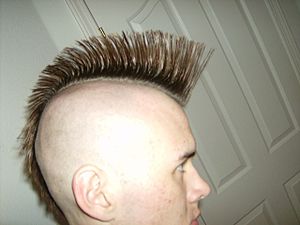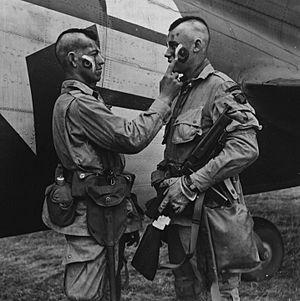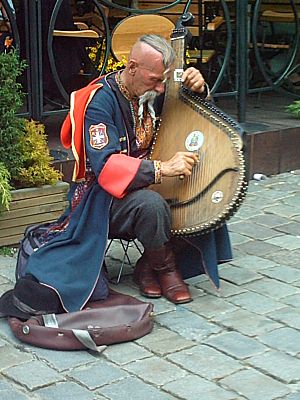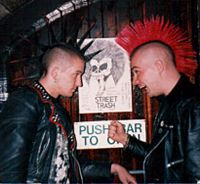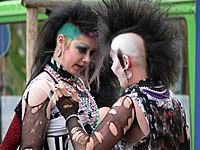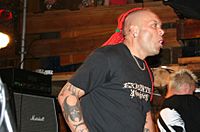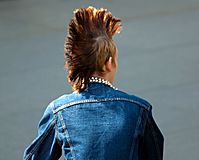Mohawk hairstyle facts for kids
The mohawk (also called a Mohican) is a unique hairstyle. In this style, the sides of the head are shaved. This leaves a strip of longer hair right in the middle. Today, many people wear it to show they are different and don't always follow trends.
Sometimes, the mohawk is called an iro. This name comes from the Iroquois people, who include the Mohawk tribe. People thought the hairstyle came from them. However, the Iroquois actually pulled out their hair instead of shaving it. Also, the mohawk style looks more like hairstyles worn by the Pawnee people. It doesn't really look like the hair of the Mohawk people or Mohicans.
An ancient body found in Ireland, called the Clonycavan Man, had a well-preserved mohawk. This hairstyle is over 2,000 years old! The world record for the tallest mohawk belongs to Kazuhiro Watanabe. His mohawk is an amazing 113.5-centimetre (3 ft 8+1⁄2 in) tall!
Contents
Where the Name Comes From
The mohawk hairstyle gets its name from the Mohawk people. They are an Native American group from North America. They used to live in the Mohawk Valley region in New York State.
But the link between the hairstyle and the Mohawk people mostly comes from Hollywood. A popular movie from 1939, Drums Along the Mohawk, helped make this connection.
The Mohawk people and other Iroquois tribes actually wore a square of hair. This hair was on the back of their head. They didn't shave their heads. Instead, they pulled out small tufts of hair at a time. This left a small square of hair.
Here is what a man named James Smith said. He was captured by the Mohawk tribe long ago:
Some Native Americans gathered around me. One of them began to pull hair from my head. He dipped his fingers in ashes to get a better grip. He kept going as if he was plucking a turkey. He pulled out all the hair except for a small spot on my crown. This spot was about three or four inches square. The hair that was left was cut, and three braids were made and decorated.
So, the real Mohawk hairstyle involved pulled-out hair. It left a three-inch square of hair on the back of the head. This hair was styled into three short, decorated braids. Today, these three braids are shown on traditional Mohawk headdresses called Gustowehs. These headdresses have three upright eagle feathers. These feathers represent the three braids from long ago.
How the Mohawk Was Used in History
This hairstyle has been around for thousands of years in many parts of the world. For example, the Clonycavan Man was found in Ireland in 2003. This ancient body was 2,000 years old. He had a mohawk styled with plant oil and pine resin.
The ancient Greek writer Herodotus wrote about a tribe in Libya called the Macai. He said they "shave their hair to leave tufts. They let the middle of their hair grow long, but shave it close to the skin all around." This sounds a lot like a mohawk!
The Pawnee people lived in what is now Nebraska and Kansas. They often wore a "mohawk" style.
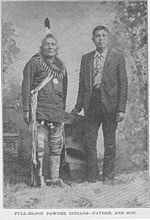
In the 1500s, Ukrainian Cossack soldiers would shave their heads before going to war. They left a long strip of hair in the middle. This haircut was called an oseledets or chupryna. They often braided it or tied it in a topknot.
During World War II, many American soldiers wore mohawks. This was especially true for paratroopers from the 17th Airborne Division. They wore them to scare their enemies. American troops also sometimes wore mohawks during the Vietnam War. In the early 1950s, some jazz musicians, like Sonny Rollins, also wore mohawks.
Different Kinds of Mohawks
A true mohawk has a narrow strip of hair standing up. It runs from the forehead to the back of the neck, with shaved sides. But the word "mohawk" can also mean other similar hairstyles. Many of these have their own names.
- A reverse mohawk (also called a nohawk or hawkmo) is the opposite. It has a shaved strip down the middle of the head. This leaves hair on both sides of the line. Early examples were seen on wrestler Road Warrior Hawk and singer Peter Gabriel.
- A fauxhawk looks like a mohawk but doesn't involve shaving the sides of the head. The hair in the middle is usually spiky but much shorter than a traditional mohawk. This style became popular again in the 2000s. Famous people like David Beckham and Elijah Wood wore it. The fauxhawk is also known as the "Hoxton fin." This is because it was popular in the Hoxton area of London in the 1990s.
- A euro-hawk is a type of fauxhawk. The hair down the center of the head is longer than the hair on the sides. Sometimes, the top hair is long enough to cover the shorter sides when combed down. Many sports stars and models wear euro-hawks. While mohawks were mostly seen on punk rockers, fauxhawks and euro-hawks are now worn by many different people. A ponyhawk or pony hawk is a euro-hawk made by a row of ponytails down the middle of the head. A contestant named Sanjaya Malakar wore this style on the TV show American Idol.
See also
 In Spanish: Mohicano (peinado) para niños
In Spanish: Mohicano (peinado) para niños


